Family : Gobiidae

Text © Giuseppe Mazza

English translation by Mario Beltramini
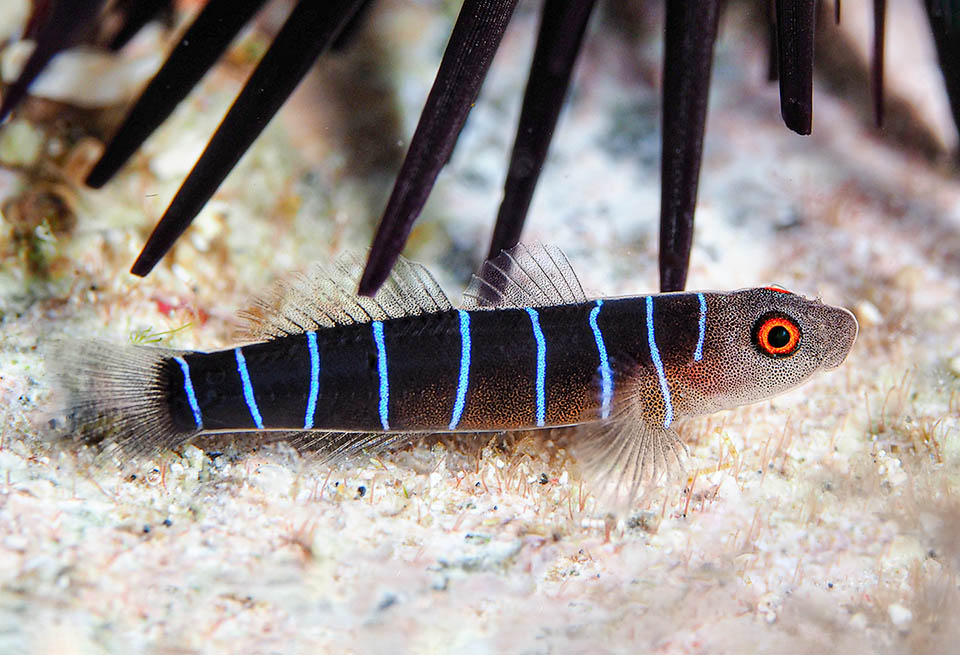
Frequent in the Caribbean, the Nineline goby (Ginsburgellus novemlineatus) does not exceed the length of 2,5 cm © Mélodie Caussat
Known as Nineline goby, Ginsburgellus novemlineatus (Fowler, 1950), belongs to the class of the Actinopterygii, the ray finned fins, to the order of the Gobiiformes, even if some scholars include it in the Perciformes and others in the Cypriniformes, and to the family of Gobiidae, one of richest in the marine world, that counts more than 200 genera and almost 2000 species, mainly present in the tropical and temperate seas, but also in brackish and fresh waters, where some fishes, called catadromous, that is, running downwards, after having spent most of their life in the rivers, reach the sea for reproducing.
The name of the genus Ginsburgellus, with the affectionate diminutive “-ellus”, honours the memory of Isaac Ginsburg (1886-1975), a US National Museum ichthyologist, whilst the specific term novemlineatus reminds us in Latin that the body of this small fish is crossed by 9 showy vertical lines.
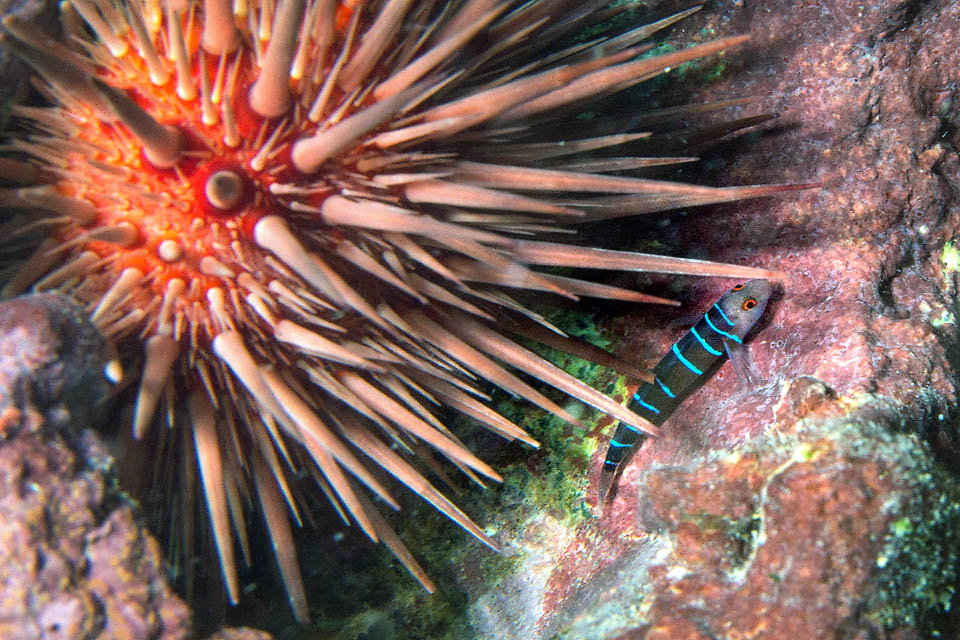
Lives sheltered by sea urchins, un particular of Echinometra lucunter, that protects by digging with the teeth niches into the calcareous substratum © Allison & Carlos Estape
Zoogeography
The Nineline goby is frequent in the Caribbean from the islands Bahamas, Turks and Caicos, Cuba, Cayman Islands, Jamaica, Haiti, Dominican Republic, Puerto Rico and the Lesser Antilles up to Trinidad and Tobago, Venezuela and Colombia.
Ecology-Habitat
It is a benthic fish of shallow and clear waters, present up to 3 m of depth, but that can be found even almost emerging in the tidal pools, hidden underneath the sea urchins.
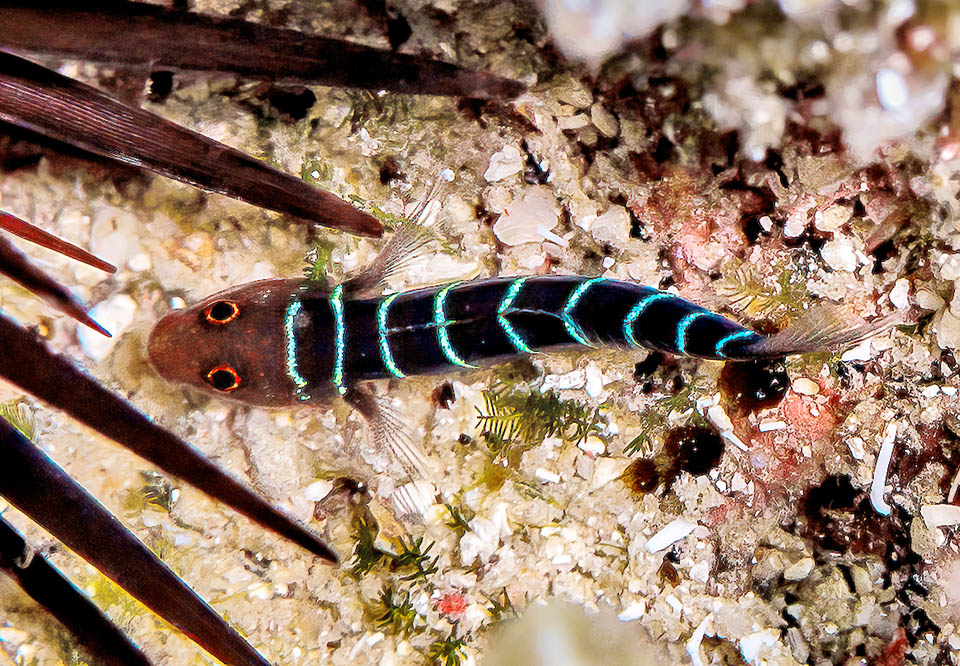
Not only takes advantage of it, disappearing under the host in case of danger, but lives eating the pedicels the urchin uses for moving © Allison & Carlos Estape
Morphophysiology
Ginsburgellus novemlineatus measures a maximum of 2,5 cm. The snout is elongated with the upper jaw protruding compared to the lower one and the upper lip, united to the head, appears free only at the back. The eyes. close together, are as far apart as the diameter of the pupil. It is scaleless and the pelvic fins, completely merged with each other, form a perfect circular sucking disk, located halfway from the anus, that serves, like all gobies, to anchor to the substratum.
We note two dorsal fins having totally 7 spiny rays and 12 soft. The caudal is slightly truncated and the pectoral fins, with 18 rays, are the motor of the fish, that moves undulating them like the puffer fishes, with a swimming rightly called diodontiform.
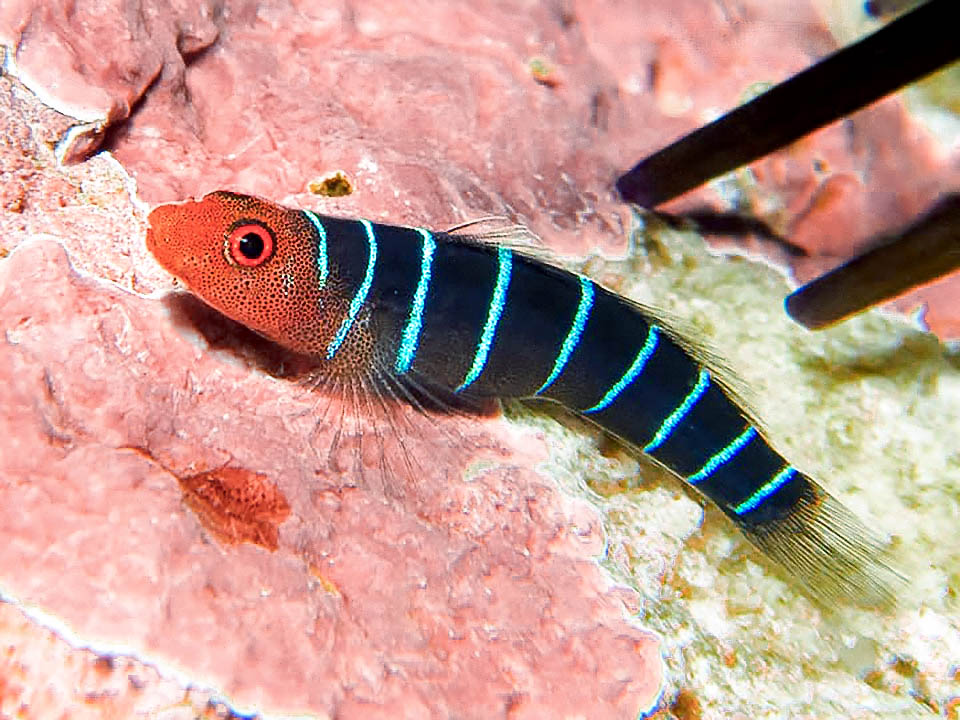
Here it is with innocent look, stuck with the pelvic sucking disk on the doorstep. If a small crustacean passes by, that will be a variation to its diet © Mickey Charteris
The upper part of the body, dark grey brown, displays nine thin turquoise blue vertical bars. The lower part of the head and the gill opening often tend to be salmon coloured and the iris of the eyes is red.
Ethology-Reproductive Biology
Though frequenting also other sea urchins, the Nineline goby, is mainly linked to Echinometra lucunter, an about 7 cm broad species, with species, with black or reddish body and short brown spines it digs with its teeth, day after day, a protective niche into the calcareous substrate. Ginsburgellus novemlineatus takes advantage of this, at times protruding only with the head, among the spines and taking complete refuge under host in case of danger. And if the urchin is raised to look at it, it darts like a rocket under the one next to it.
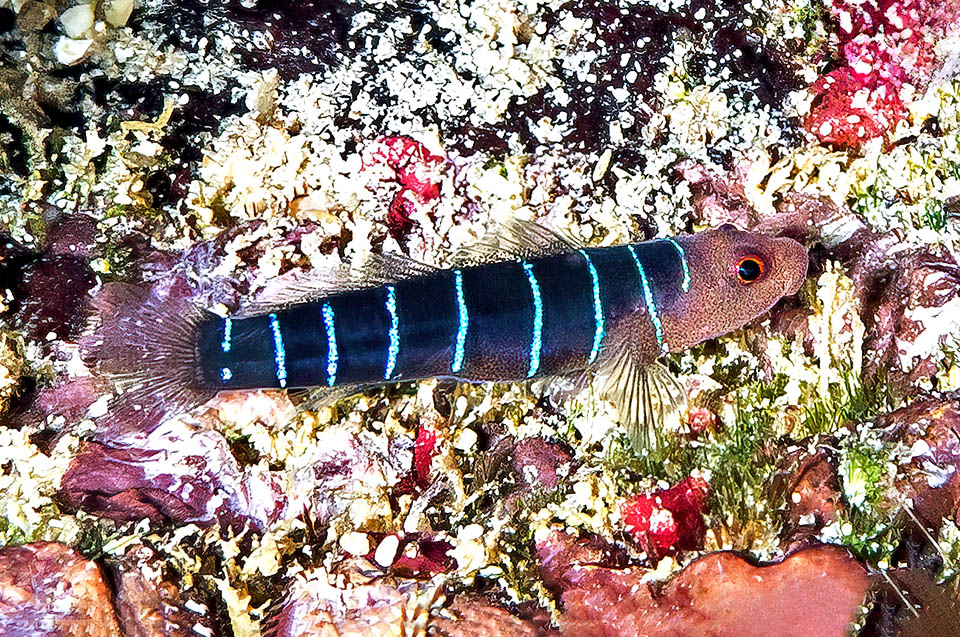
Ginsburgellus novemlineartus eggs are laid and fecundated on the bottoms. The pelagic larvae, carried by the currents, spread the species © Allison & Carlos Estape
These echinoderms are its salvation and take advantage of it too, shamelessly, nourishing mostly of their tubular pedicels. Of course, if they come within range, it does not ignore the small benthic crustaceans passing by, and nibbles on the sea cucumbers and the starfishes in the surrounding area.
The eggs are placed in a madreporic niche or on the rocky bottom and the pelagic larvae spread the species. The resilience of Ginsburgellus novemlineatus is excellent, with a minimum time for doubling of the populations of less than 15 months, and the fishing vulnerability index stands among the lowest, marking only 10 on a scale of 100. From 2011, in fact, it appears as “LC, Least Concern” in the IUCN Red List of the Endangered species.
Synonyms
Ginsburgellus novemlineatus (Fowler, 1950); Gobiosoma novemlineatum Fowler, 1950.
→ For general information about FISH please click here.
→ For general information about BONY FISH please click here
→ For general information about CARTILAGINOUS FISH please click here.
→ To appreciate the BIODIVERSITY of BONY FISH please click here.
→ To appreciate the BIODIVERSITY of CARTILAGINOUS FISH please click here.
